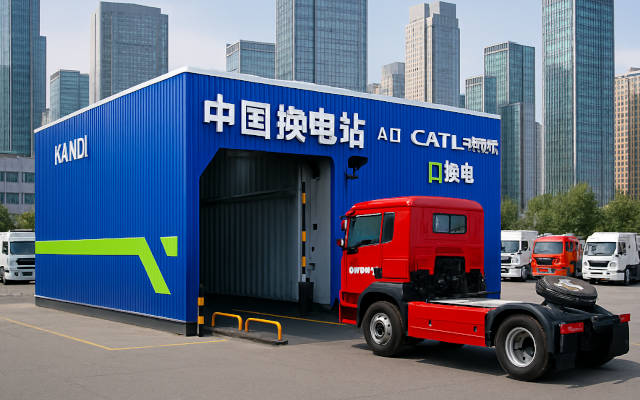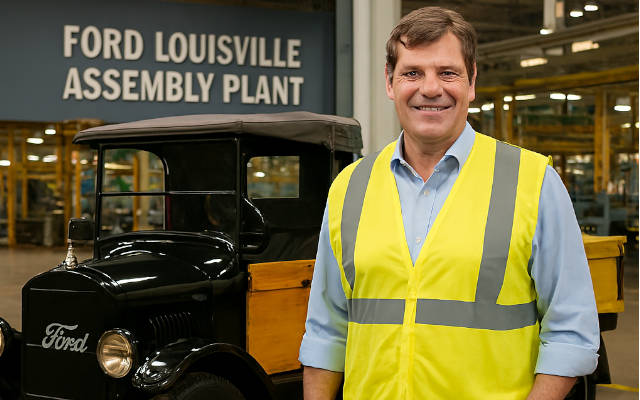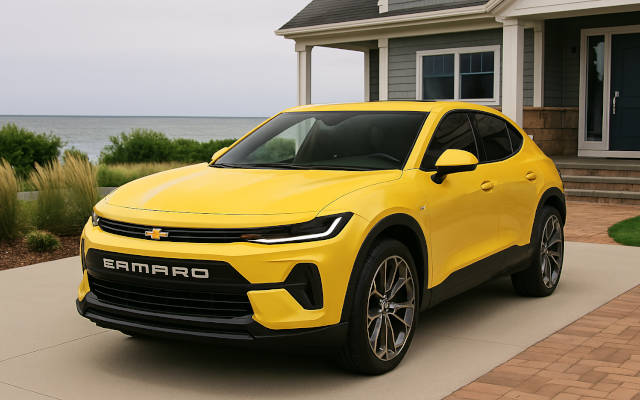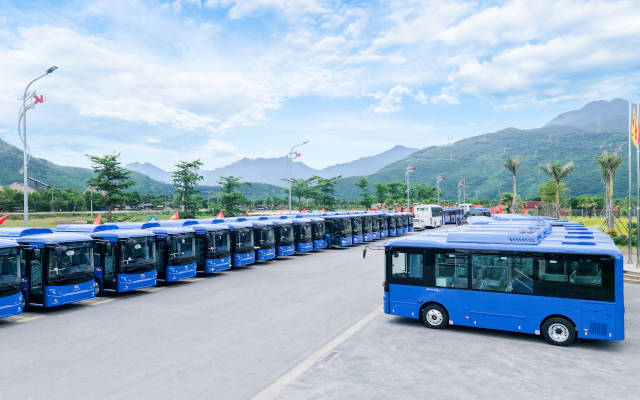 EDITOR'S PICK
EDITOR'S PICK
Most EV-friendly Premier League Football Stadiums In The UK
12 Aug 2025 | Synopsis
 The surge in EV chargers near Premier League stadiums marks a win for UK drivers, showing that charging is expanding beyond motorways into busy urban hubs. Football matchdays draw huge crowds, making accessible chargers crucial for reducing range anxiety. This growth signals broader public charging integration into everyday destinations, supporting the UK's EV adoption goals and making matchday travel cleaner.
The surge in EV chargers near Premier League stadiums marks a win for UK drivers, showing that charging is expanding beyond motorways into busy urban hubs. Football matchdays draw huge crowds, making accessible chargers crucial for reducing range anxiety. This growth signals broader public charging integration into everyday destinations, supporting the UK's EV adoption goals and making matchday travel cleaner.Kandi Technologies Emerges as Key Player in China's Battery Swap Revolution
12 Aug 2025 | Synopsis
 Kandi Technologies - a once modest budget EV maker - is now a central player in China's battery swap infrastructure. Its subsidiary, China Battery Exchange, will supply key components (station structures, robotic arms, thermal modules) for CATL's ambitious plan to deploy over 10,000 swap stations nationwide. With 90-second swaps, both single-use and subscription pricing, Kandi is targeting fleet operators while drawing investor attention.
Kandi Technologies - a once modest budget EV maker - is now a central player in China's battery swap infrastructure. Its subsidiary, China Battery Exchange, will supply key components (station structures, robotic arms, thermal modules) for CATL's ambitious plan to deploy over 10,000 swap stations nationwide. With 90-second swaps, both single-use and subscription pricing, Kandi is targeting fleet operators while drawing investor attention.Ford Throws Out Henry Ford's Assembly Line To Make Low-Cost EVs In America
12 Aug 2025 | Synopsis
 Ford is scrapping its century-old straight-line assembly line for a three-branch "assembly tree" setup, enabling parallel construction of EV modules. Investing almost $5 billion, Ford will retool its Louisville plant, aiming to produce a mid-size electric pickup starting at $30,000 in 2027. Powered by cost-effective domestic LFP batteries, the overhaul is designed to cut assembly complexity, speed up production, and bolster U.S. competitiveness.
Ford is scrapping its century-old straight-line assembly line for a three-branch "assembly tree" setup, enabling parallel construction of EV modules. Investing almost $5 billion, Ford will retool its Louisville plant, aiming to produce a mid-size electric pickup starting at $30,000 in 2027. Powered by cost-effective domestic LFP batteries, the overhaul is designed to cut assembly complexity, speed up production, and bolster U.S. competitiveness.Return of the Chevy Camaro, But This Time It's An Electric SUV
12 Aug 2025 | Synopsis
 The Camaro is set to return as an electric fastback SUV - not a coupe - slated for fall 2026. Expected variants range from single-motor, rear-drive models (241–365 hp) to dual-motor AWD (300 hp) and high-performance SS (615 hp) trims, with a possible 1,000-hp ZL1 using Hummer EV tech. Battery options likely include 85 kWh and 102 kWh packs, with charging up to 190 kW. Prices are estimated between $36,000 and $65,500.
The Camaro is set to return as an electric fastback SUV - not a coupe - slated for fall 2026. Expected variants range from single-motor, rear-drive models (241–365 hp) to dual-motor AWD (300 hp) and high-performance SS (615 hp) trims, with a possible 1,000-hp ZL1 using Hummer EV tech. Battery options likely include 85 kWh and 102 kWh packs, with charging up to 190 kW. Prices are estimated between $36,000 and $65,500.Dozens Of New Electric Bus Routes For Vietnam's Ho Chi Minh City
08 Aug 2025 | Synopsis
 Ho Chi Minh City introduced 27 new electric bus routes on August 1, adding 443 electric buses and boosting its total EV fleet to 613—now over 26% of its public bus system. Combined with around 500 CNG buses, almost half the fleet runs on clean energy. The new vehicles - models B30‑EV and B60‑EV - offer 30–60 seats, GPS, onboard cameras, free Wi‑Fi, automated announcements, and cashless payment. Authorities aim for a fully green bus fleet by 2030.
Ho Chi Minh City introduced 27 new electric bus routes on August 1, adding 443 electric buses and boosting its total EV fleet to 613—now over 26% of its public bus system. Combined with around 500 CNG buses, almost half the fleet runs on clean energy. The new vehicles - models B30‑EV and B60‑EV - offer 30–60 seats, GPS, onboard cameras, free Wi‑Fi, automated announcements, and cashless payment. Authorities aim for a fully green bus fleet by 2030.
 EVWorld Exclusive
EVWorld Exclusive
Horse Powertrain: The Hybrid Trojan Horse
17 Oct 2025 |  Horse Powertrain, a joint venture by Renault, Geely, and Aramco, offers compact hybrid engines like the C1 to retrofit EV platforms. Designed as range extenders, these engines run on multiple fuels and meet Euro 7 standards. Though marketed as green tech, their real-world impact is debated - especially as studies show PHEVs are rarely charged. Horse may be a transitional solution, but 500-mile EVs are poised to dominate long-term.
Horse Powertrain, a joint venture by Renault, Geely, and Aramco, offers compact hybrid engines like the C1 to retrofit EV platforms. Designed as range extenders, these engines run on multiple fuels and meet Euro 7 standards. Though marketed as green tech, their real-world impact is debated - especially as studies show PHEVs are rarely charged. Horse may be a transitional solution, but 500-mile EVs are poised to dominate long-term.
Sticker Shock and Stagnant Pay: Why New Cars Are Slipping Out of Reach
17 Oct 2025 |  New car prices have outpaced wage growth, making ownership increasingly unaffordable. Even Ford's $30K EV pickup and other sub-$30K models may remain out of reach for many without incentives or financing reform. With monthly payments rising and federal credits phasing out, the affordability gap is reshaping the auto market. Shared mobility and micro-EVs may offer alternatives, but structural change is needed to restore access.
New car prices have outpaced wage growth, making ownership increasingly unaffordable. Even Ford's $30K EV pickup and other sub-$30K models may remain out of reach for many without incentives or financing reform. With monthly payments rising and federal credits phasing out, the affordability gap is reshaping the auto market. Shared mobility and micro-EVs may offer alternatives, but structural change is needed to restore access.
Toyota FT-Me: Shared Mobility Concept with Big Implications
17 Oct 2025 |  Toyota's FT-Me is a two-seat electric microcar designed for shared urban mobility, not just teens. Developed with UK government support, it features hand-only controls, solar panels, and a lightweight frame. Aimed at car clubs and last-mile use, it could offer affordable, accessible transport with low emissions. With steady utilization and supportive policy, FT-Me may become a viable, sustainable option in the UK's evolving mobility landscape.
Toyota's FT-Me is a two-seat electric microcar designed for shared urban mobility, not just teens. Developed with UK government support, it features hand-only controls, solar panels, and a lightweight frame. Aimed at car clubs and last-mile use, it could offer affordable, accessible transport with low emissions. With steady utilization and supportive policy, FT-Me may become a viable, sustainable option in the UK's evolving mobility landscape.
Creative Destruction vs. Fossil Retrenchment: Why Project 2025 Risks Leaving America Behind
16 Oct 2025 |  Project 2025 protects fossil fuel incumbents by dismantling Biden-era clean energy policies. Nobel economist Philippe Aghion argues that climate progress depends on creative destruction - letting green innovators outcompete legacy polluters. The U.S. risks falling behind as global markets embrace clean tech. Even its passport has slipped from the top 10. Innovation, not retrenchment, is the path forward
Project 2025 protects fossil fuel incumbents by dismantling Biden-era clean energy policies. Nobel economist Philippe Aghion argues that climate progress depends on creative destruction - letting green innovators outcompete legacy polluters. The U.S. risks falling behind as global markets embrace clean tech. Even its passport has slipped from the top 10. Innovation, not retrenchment, is the path forward
Buick Electra E5: China-Built EV Poised for U.S. Launch
16 Oct 2025 |  Buick's Electra E5, built in China by SAIC-GM, is set to become GM's first imported EV for the U.S. market. Though its launch was delayed indefinitely in 2024, a tentative 2026 rollout remains part of GM's electrification roadmap. With Ultium battery tech, strong performance specs, and positive reception in China, the Electra E5 represents a strategic shift in global EV sourcing and branding.
Buick's Electra E5, built in China by SAIC-GM, is set to become GM's first imported EV for the U.S. market. Though its launch was delayed indefinitely in 2024, a tentative 2026 rollout remains part of GM's electrification roadmap. With Ultium battery tech, strong performance specs, and positive reception in China, the Electra E5 represents a strategic shift in global EV sourcing and branding.
 19 Oct 2025 07:55:04 UTC |
RECENT PODCASTS
#TUBER Makes Elon Musk $19B Richer - Ebike Fires - EVs Help the Grid
SEARCH RSSTREAM
 32 New Postings In Past 24 Hours
32 New Postings In Past 24 Hours
Category:energy
Region:NoAmerica
Date:18 Oct 2025
Category:finance
Region:NoAmerica
Date:18 Oct 2025
Category:energy
Region:NoAmerica
Date:18 Oct 2025
Category:energy
Region:NoAmerica
Date:18 Oct 2025
Category:mobility
Region:NoAmerica
Date:18 Oct 2025
Category:finance
Region:NoAmerica
Date:18 Oct 2025
Category:mobility
Region:NoAmerica
Date:18 Oct 2025
Category:finance
Region:NoAmerica
Date:18 Oct 2025
Category:finance
Region:NoAmerica
Date:18 Oct 2025
Category:mobility
Region:NoAmerica
Date:18 Oct 2025
Category:finance
Region:NoAmerica
Date:18 Oct 2025
Category:mobility
Region:Europe
Date:18 Oct 2025
Category:mobility
Region:Europe
Date:18 Oct 2025
Category:finance
Region:NoAmerica
Date:18 Oct 2025
Category:autonomy
Region:NoAmerica
Date:18 Oct 2025
Category:mobility
Region:NoAmerica
Date:18 Oct 2025
Category:finance
Region:NoAmerica
Date:18 Oct 2025
Category:policy
Region:NoAmerica
Date:18 Oct 2025
Category:policy
Region:NoAmerica
Date:18 Oct 2025
Category:policy
Region:NoAmerica
Date:18 Oct 2025